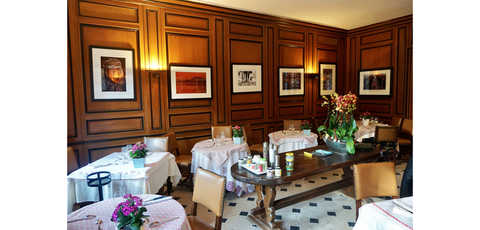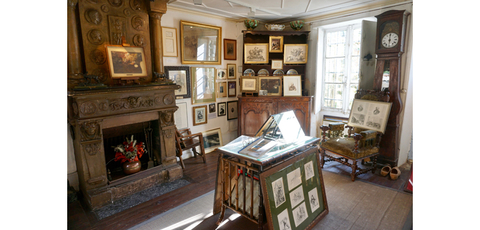Our outing this month took us only forty-minutes from Gare de Lyon train station in the center of Paris. We took the train to Fontainebleau, where the famed Chateau de Fontainebleau, a royal palace rivaling Versailles and inhabited by King Louis XIII and XVI is located. Once in Fontainebleau, we took a 15-minute taxi ride to Barbizon.
Barbizon is a tiny, idyllic village in the middle of thousands of acres of dense forestland. The bucolic area surrounding Barbizon has open meadows of grass surrounded by the forest and was a haven for a school of painters between 1830 and 1870.
We arrived at the Hôtellerie du Bas-Bréau, a four-star hotel in the heart of town, for a tour of the rooms and an invitation to have lunch at the restaurant. The owners, Jean-Pierre Fava and his wife Dominique, warmly greeted us (the handsome couple have privately owned and run the hotel for 50 years, a rarity these days). In fact, Jean Pierre at 75 years old, still wakes up at 1 a.m. and returning at 8 a.m., twice a week, to stock up on food for the restaurant at the Rungis wholesale food market.
The magnificent grounds of the hotel are set on three acres of a private park and landscaped with squared formal hedges, manicured lawns, classic statues, and massive trees. It was the height of the fall foliage and the leaves of crimson and marigold heightened the beauty of the grounds. There’s an area on the side with a heated pool on a wooden deck.
Hotellerie de Bas-Bréau has 16 rooms, four suites and one villa, ranging in size from a spacious 300 square feet for a standard room to 600 square feet for the junior suite. All rooms are individually decorated in different styles ranging from rustic and cozy with colors of red, rust, mustard and green, to a more formal style including toile de Jouy prints with a canopy bed. Each oversized bathroom has a mini-spa with a Jacuzzi tub.
Despite the small room count, the hotel offers three dining options. We dined in the more informal bistro, although we had the tasting menu from the traditional restaurant. Fontainebleau has been renowned for centuries for its broad hunting forests; since autumn is hunting season and also the wild mushroom harvest, the restaurant offers a specialized menu of game and mushrooms.

The intimate bistro has 12 tables in a soothing atmosphere with paned windows overlooking the picturesque village. Jean-Pierre said the dish of roe deer garnished with fall vegetables and mushrooms was a must, if we wanted to have a true local specialty. Although the texture was more like a filet mignon, there was a distinct and pleasant game taste to the deer. Our steaming Grand Marnier soufflé was the perfect light dessert to finish our excellent meal.
Jean-Pierre shared the fascinating history of the hotel; the oldest part of the hotel, the reception area and restaurant, was originally a horse stable and carriage house. The big claim to fame is Robert Louis Stevenson wrote Treasure Island while staying at the hotel, where he also met his future wife Fanny. Numerous luminaries, royalty, celebrities and politicians have stayed in the hotel over the years including Queen Elizabeth, Princess Grace of Monaco, Mick Jagger, Robert De Niro, Yves Saint Laurent and Francoise Sagan. A special moment for Jean-Pierre was when Hirohito, the emperor of Japan, came to the hotel. Hirohito traveled out of Japan only one time during his reign and one of the three places he visited was the Hotellerie de Bas-Bréau.
After lunch we toured the tiny village of Barbizon, with just one, long main street. Although there are modern-day restaurants, and services, the road retains a time capsule of the 1700s and 1800s with its low buildings covered with wild vines, exposed stone walls, iron gates, half timber houses and stone cottages.
Another reason why artists were attracted to the area, besides the wild beauty of the forest and open meadows, was for the indescribable light, which would dramatically alter during the course of the day with fast moving clouds.

We visited two small museums featuring history and works of the Barbizon School of Painting.
Jean-Francois Millet is the most recognized artist of the Barbizon school, painting stunning landscapes with farm workers and outdoor workers in the background. La Maison et Atelier de Jean-Francois Millet is the former home and atelier of the artist and the rooms showcase his private possessions, his art, and family life. In the late 1800s, Van Gogh was so taken with Millet’s work, he declared he was his master and painted 40 replicas of Millet’s paintings as an homage.
A little further down the road is Musée de Barbizon, the official museum of Barbizon. Formerly an inn and tavern, the main floor consisted of two dining rooms and the kitchen. Artists were so poor that they exchanged their paintings for food and lodging. Upstairs was a series of empty rooms with drawings on the walls, which were an early form of graffiti, scrawled on the walls by the painters, who sometimes didn’t even have enough money to afford paper or canvas to paint on.
Another lovely homage is a series of replicas of the most iconic paintings from the Barbizon school, made of mosaic tiles line the main street.
Barbizon is an ideal daytrip from Paris but if you want to stay at Hotellerie de Bas-Bréau overnight, you will also have time to visit Chateau de Fontainebleau. Visit www.musee-chateau-fontainebleau.fr.
Trains leave approximately three times an hour from Gare de Lyon to Fontainebleau and ticket price is €8.85, one-way.
parisbytrain.com/paris-to-fontainebleau-by-train/
Hotellerie de Bas-Bréau
22 Rue Grande, 77630 Barbizon
www.bas-breau.com/uk/index.php
Related Stories
Stats: U.S. Visits to Paris to Rise 16.3% Over Holidays
Specialty Pastry Shops in Paris You Need to Try